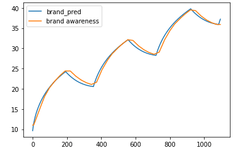What's the long term effect on brand?
Traditional brand marketers can’t justify the impact of their campaigns, and yet performance marketers have a short term bias that can wreck your company. They both fight over budget, so how do we reconcile the two?
Times are tough, I’m having to cut budgets across the board, and we can’t continue having a budget that’s based on a fluffy metric like “brand awareness”
I know brand must have some long term effect
But without knowing how much, how can we justify carving off half of our budget?
The performance guys can tell me to the penny how much revenue we’re driving
It can’t be a two-track system
We need to find a way to link brand awareness to future sales, or I’m going to have to reallocate the budget
There must be something we can do to account for brand awareness in our marketing mix model
Can you look into this as a matter of urgency?
This course is a work of fiction. Unless otherwise indicated, all the names, characters, businesses, data, places, events and incidents in this course are either the product of the author's imagination or used in a fictitious manner. Any resemblance to actual persons, living or dead, or actual events is purely coincidental.
Conversations around brand versus performance are fraught with politics because the difficulty of measuring long term effects leaves open a chasm of uncertainty around what the right budget split should be. If you believe in the value of brand advertising you may over-allocate to long term activities at the expense of more dependable short term returns. Alternatively allocating everything to short-term performance marketing will cause issues from under-investment. Ideally you capitalise on fulfilling demand in the short term, while also investing in generating demand over the medium and long term. How you make that split will make a big difference: either the brand or performance team will be short-changed if you get it wrong, and there is no standardised or widely accepted way of doing this type of analysis. To make matters worse, the average tenure of a CMO is 4 years, meaning they usually won’t be around to see if their campaigns succeeded or failed in driving a long term benefit.
The work of Binet and Field in “The Long and Short of it” recommends a 60:40 split between short term activation and long term branding activities, after doing a meta analysis of IPA award winning campaigns. However this dataset suffers from selection bias (only award winning entries) and even the author’s admit this is a guide not a rule: the optimal amount will be different by brand, company stage, and sector. Many attempts have been made to estimate the long term impact of brand campaigns, and some of this effect is covered by adstock rates in marketing mix models: transforming the data so some of the effect of brand spend carries on to future time periods. However adstocks are rarely sufficient for long term brand awareness, as high adstock rates make the impact hard to distinguish from the constant term in the linear regression. Literally: where does the baseline sales end and the impact of the brand campaigns begin?
These are difficult questions to answer, but a recent session at the Meta Marketing Mix Modeling summit by GfK and and Nepa, entitled “Measuring long term effects with MMM”, shows some promise in an elegant approach for bringing brand and performance together. The technique centers around embedded modeling, essentially building a model that predicts brand awareness over the long term, and embedding the outputs of that model in your base sales model as an input. That way you can predict long term drivers of brand awareness, while also forecasting forward to what the total impact of a brand campaign today might have in the future, as well as what the payback period might be.
Complete all of the exercises first to receive your certificate!
Share This Course
